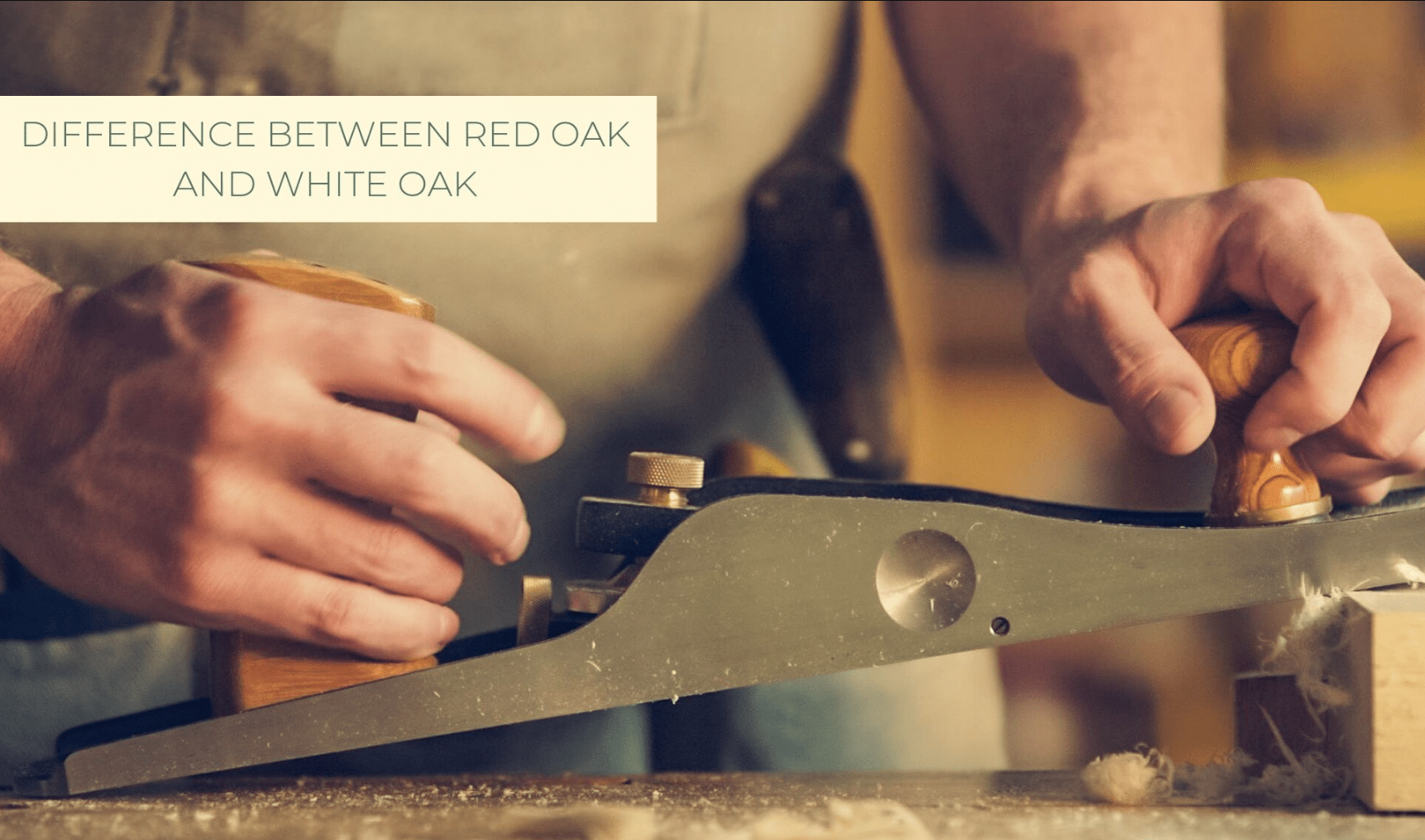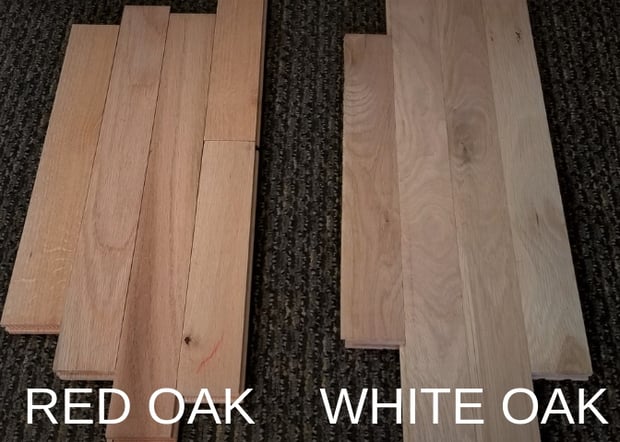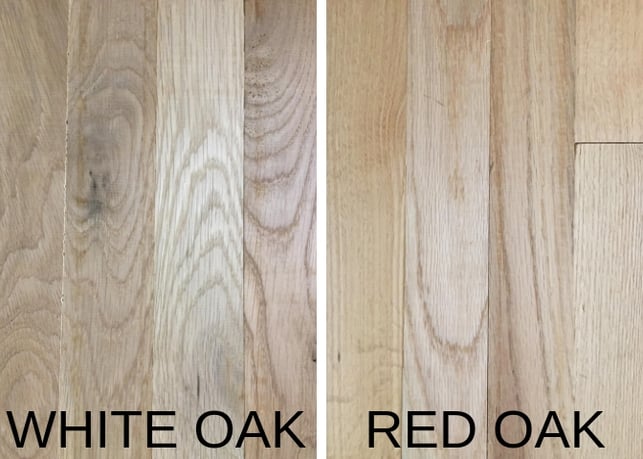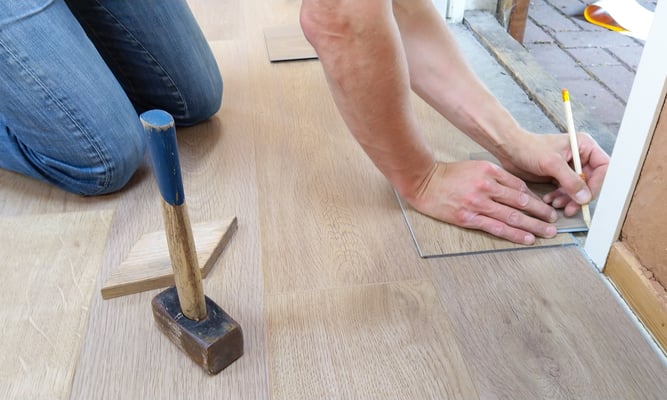
Difference Between Red Oak and White Oak
What’s the difference between Red Oak v/s White Oak? This is a very common question most of us come across especially when we are looking into Oak flooring for a commercial design project or a home remodel/renovation. Let’s dive deeper into understanding the ways to differentiate between a Red Oak and White Oak floor along with what makes them different in terms of workability, cost and use.

COLOR
Red Oak wood is a lighter shade wood than compared to White Oak. Red Oak wood tends to be slightly reddish to amber color where as White Oak tends to be bit browner and more yellowish in shade. While comparing raw Oak wood, its fairly easy to make out the difference with a naked eye however if you have a finished Oak floor, it would be hard to identify if your floor is Red Oak or White Oak. In that case, there are other reliable tests that you can perform to find out if your wood is Red Oak or White Oak.

HARDNESS
Both Red Oak and White Oak are very durable woods. According the Janka hardness test, White Oak flooring scores a 1360 while Red Oak is at 1290. Some might argue that the inherent hardness and density of White Oak makes it slightly more stable and durable compared to Red Oak for wood flooring, but both types of hardwood flooring will work well.

GRAIN PATTERN
Red Oak grain patterns tend to be more complex and intricate than the finer grain pattern of White Oak which is more subtle in its appearance, giving it a more consistent look. The grain in White Oak runs straighter and tighter than Red Oak, with fewer swirls, circles or deviations. Red oak also has wider grain lines that can run in zigzag patterns, or subtle, wavy lines that are absent from White Oak. Another reason that Red Oak flooring displays a more prominent grain pattern than White Oak is because it is a lighter wood than White Oak. And on the other hand, the smoother look of White Oak can also be attributed to the fact that the dark grain is less noticeable against the darker wood. (Check out Castle Bespoke’s exclusive White Oak products on our Products page)
– End Grain:
Red Oak end grain has pin holes, where as White Oak end grain does not and tends to have a more glazed look.
– Rays:
The rays which are the sides of the pin holes are much longer in White Oak Floors as compared to a Red Oak floor. A Red Oak floor would typically have 1/4″ long rays as compared to 3/4″long rays in a White Oak floor. If you are working with a finished floor, it is a good way to identify if your wood is Red Oak or White Oak.

SHAVING TEST
This is a 100% test where you can take shavings of the wood and soak it in a dish with a solution of 5% Sodium Nitrite to Water (By weight not volume). If it’s red oak, there will only be a small color change, making the wood only slightly darker. But if it’s white oak, there will be a noticeable color change in as little as five minutes, (though it can take longer if the wood is dry, or if the temperature is low). The heartwood of white oak will eventually change to a dark indigo to almost black. This method is extremely accurate and reliable and, if you’re ever in a situation where you can’t separate between red and white oak based on anatomy, this method is nearly foolproof. (Though, only the heartwood will bring about the color change, not the sapwood.) Recipe for 10% Sodium Nitrite Solution for Testing Oaks: 1 cup water + 4 teaspoons sodium nitrite ( Directions: Stir in sodium nitrite until clear. Clearly label solution to avoid confusion; sodium nitrite is very dangerous if ingested. ). However, if you dont want to take the hassle of making the formula yourself, you can buy a Woodwise test kit at Greenpointe Online
USAGE
Even though White and Red Oak wood are both used for flooring, White Oak has been much more desirable and envied over the years as it can produce some of the finest grain patterns (Check out Castle Bespoke’s project portfolio to witness the magic of White Oak floors). Through history White Oak has been used for fine furniture, architectural moldings and trim, beams, railroad ties, fence posts, mine timbers, ships, caskets and whiskey barrels. Red Oak has also been common in cabinets and everyday items such as desks, chairs, molding and flooring.
COST
Since Red oak is the industry standard, grow more rapidly and is more common across the USA, Red Oak flooring tends to be cheaper and more readily available than White Oak flooring. Top end solid or engineered White Oak flooring can cost as much as $11-13 per square foot, compared to $7-9 per square foot for the top grade red oak planks. However, with so much competition on the market you can find both solid red oak and white oak flooring ranging from $3 to $5 per square foot. Both red oak and white oak are also available in engineered hardwood planks, which are often cheaper than solid flooring.
ENVIRONMENTAL FOOTPRINT
Both Red and White Oak are considered to be a “green” use of natural resource. The carbon footprint of both types of wood is lower than that of exotic wood species like Brazilian Cherry or Tigerwood.

WORKABILITY
When working either species, you may notice differences in how they feel in your hands and how the machines react to them. The inherent hardness of white oak can make a saw blade burn, chatter or skip if it is even slightly dull. White oak is also more brittle than red oak and will splinter or even shatter if the wood is introduced into a blade a bit too fast. Red oak cuts smoother and has a slightly pliable quality to it that prevents it from shattering or breaking as easily as white oak. When working with hand tools such as chisels, red oak is far easier to carve.
CHARACTERISTICS
White Oak tends to be more resistant to rot and water as compared to Red Oak, which makes it an excellent choice for outdoor furniture and flooring. This is because White Oak has smaller, closed off pores, whereas Red Oak has larger pores. However the larger pores in Red Oak make it easier to stain deeply and evenly. As mentioned above, along with being harder than red oak, white oak is also more stable and denser than red oak. However, for best results in terms of stability, both red oak and white oak planks should be allowed to fully adapt to the local environments before installation.
SO WHAT SHOULD YOU GO FOR?
- White oak is much more is suitable for water-holding applications such as boat building, outdoor furniture, luxury flooring etc. where as Red oak is suitable for interior pieces such as cabinets, indoor furniture, flooring.
- Red Oak tends to have wider grain lines which can be more wavy and Red Oak tends to displays a more prominent grain pattern than White Oak is because it is a lighter wood than White Oak. If you are looking for a cleaner grain then White Oak is the better choice.
- As far as cost goes, Red Oak is comparatively cheaper than White Oak. In terms of flooring, White Oak tends to add $1-$2 more compared to Red Oak floor of the same quality.
Let’s work together
Start your flooring project today.
Castle Bespoke listens. We hear it from our customers over and over again. Let us help you create your dream floor, your showpiece. Contact us now and get the process started. We make it easy and enjoyable to create a custom, sustainable wood floor.

.jpg?width=653&name=RED%20OAK%20(1).jpg)


